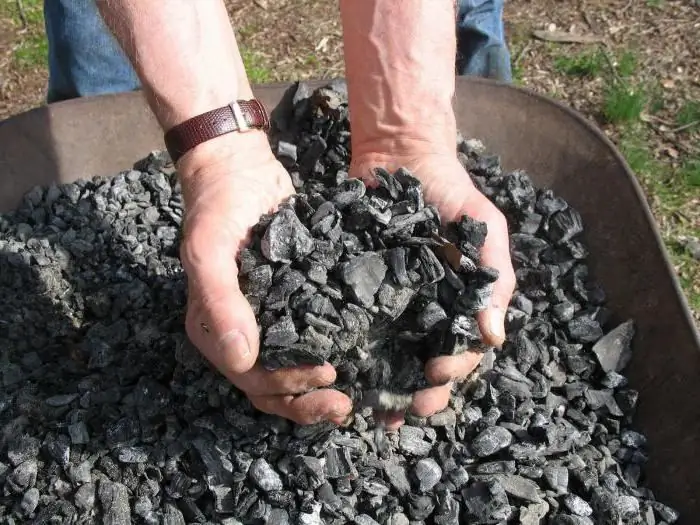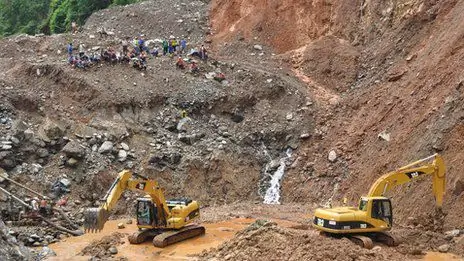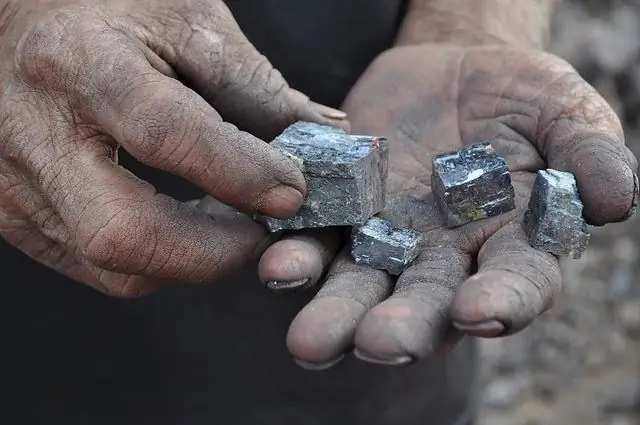2026 Author: Howard Calhoun | [email protected]. Last modified: 2025-01-24 13:10:26
The use of lignite is not as widespread compared to its stone counterpart, but the low cost makes heating with this fossil relevant among small and private boiler houses. In Europe, this rock is also called lignite, although it is rarely distinguished from the general classification of coal. As for the intended purpose, for example, in Germany it is used to supply steam power plants, and in Greece brown coal can generate up to 50% of electricity. But again, this material does not have wide distribution as a type of solid fuel, at least in the form of an independent resource.
General information about brown coal

Lignite is a dense stone-like mass of light brown or black color. On closer inspection, you can see its vegetative woody structure. In the boiler room, brown coal burns out rather quickly with the release of soot and a peculiar smell of burning. As for the composition, it is formed by ash, sulfur, carbon, hydrogen and oxygen. The impurities correspond to the same elements found in other types of coal.
In terms of material composition, most of these fossils belong to humites. Transitional sapropelite and humus inclusionsoccur in the form of interlayers in deposits of humites. In basins, brown coal is grouped by vitrinite microcomponents. It should be noted that the ash components in such deposits are the most difficult to calculate. To calculate thermal performance, it is recommended to refer to special tables and compare rock data with the characteristics of the boiler room equipment.
Origin of deposits

The largest deposits are characteristic of the Mesozoic-Cenozoic groups of sediments. As an exception, only the Lower Carboniferous deposits of the Moscow Region basin can be distinguished. European deposits are predominantly associated with formations of the Neogene-Paleogene period, while Jurassic deposits predominate in Asia. Fossils of the Cretaceous period are less common. Russian reserves also mostly contain material from Jurassic deposits. Most of the fossils occur at shallow depths (10-60 m). Due to this factor, open-cast coal mining is allowed, although there are also problematic channels up to 200 m. The main raw material for the formation of lignite was once deciduous and coniferous trees, peat bogs and pyals. Carbon enrichment is due to the fact that the decomposition process took place under water and without air access. Also, the wood base was mixed with sand and clay, due to which the further stage of the transformation of deposits forms graphite.
Coal mining

Russia ranks fifth in terms of lignite production. About 75% of the total volume of minerals is supplied by industrial andfuel and energy enterprises, and the rest is used in the chemical industry and metallurgy. A small share is also exported. The technology of development and direct production in general resembles the methods of working with other varieties of carbon deposits. But mining brown coal has its advantages. Since this rock is relatively young, a large proportion of the resource is extracted from open deposits. To date, this method is the most effective, safe and cheap. True, from an environmental point of view, this is not the best method of extraction, since the development of deep pits entails extensive dumps of so-called overburden.
Large deposits

If we talk about Russia, then the largest deposit of brown coal is the Solton complex of quarries. This is the only source of coal located in Altai. According to experts, this deposit contains about 250 million tons of rock. Also known is the Kansk-Achinsk multi-kilometer brown coal basin, which is located in the Krasnoyarsk Territory. In both cases, mining is carried out using open technology. Quite promising deposits of lignite are also being developed in Germany, which is the largest supplier of this coal in Europe. The most large-scale developments are carried out in East Germany, where the Middle German and Lausitz basins are located. According to some reports, these deposits contain 80 billion tons. As in Russia, German specialists are oriented towards open pit mining, moving away fromexpensive mine method.
Cost of brown coal
In terms of quality, brown coal loses to its more familiar stone counterpart. At the same time, several factors made it possible to slightly increase the demand for a less attractive resource. Among them, one can note the cost at which lignite is sold. The average price varies from 800 to 1200 rubles. for 1 ton. The higher the calorific value, the higher the price tag. For comparison: a ton of coal can be purchased at best for 2,000 thousand rubles. As already mentioned, the nuances of operating boiler houses when using brown coal still prevent its wide distribution. But suppliers of quality material find customers both among energy companies and in the segment of individual consumption.
Conclusion

Lignite can be supplied to the end consumer in sorted or unsorted form. As a domestic fuel, it is usually used for pulverized combustion, and for complex metallurgical industries, coke briquettes are made from it. Due to the low cost and wide distribution of large deposits, brown coal is not the last in the list of popular fuel materials. Nevertheless, against the background of increasing requirements for energy efficiency of heating systems and tightening environmental standards, such raw materials are becoming less and less attractive. In many countries, the use of brown coal is limited only to production needs, but the examples of Russia and Germany confirm andthe relevance of the breed in terms of domestic use.
Recommended:
Coal: mining in Russia and in the world. Places and methods of coal mining

The coal mining industry is the largest segment of the fuel industry. Every year, the level of coal production increases all over the world, new technologies are mastered, equipment is improved
Gold mining. Gold mining methods. Mining gold by hand

Gold mining began in ancient times. In the entire history of mankind, approximately 168.9 thousand tons of precious metal have been mined, almost 50% of which goes to a variety of jewelry. If all the mined gold is collected in one place, then a cube would be formed as high as a 5-storey building, having an edge - 20 meters
Anthracite (hard coal): characteristics and mining sites

Anthracite is a kind of high quality fossil coal. It is characterized by a high level of metamorphism (degrees of solid-phase and structural mineral change). More on this later
Silver mining: ways and methods, main deposits, leading countries in silver mining

Silver is the most unique metal. Its excellent properties - thermal conductivity, chemical resistance, electrical conductivity, high ductility, significant reflectivity and others have brought the metal to be widely used in jewelry, electrical engineering and many other branches of economic activity. For example, mirrors in the old days were made using this precious metal. At the same time, 4/5 of the total produced volume is used in various industries
Elga deposit in Yakutia. OAO Mechel. Elga coal deposit

In the 20th century, taiga grew on the site of the open Elga coal deposit. Now there is no forest; Russians are not greedy, they can share we alth. But companies implementing global projects need to think carefully about what they will leave to their descendants - a livable land or lunar landscapes

